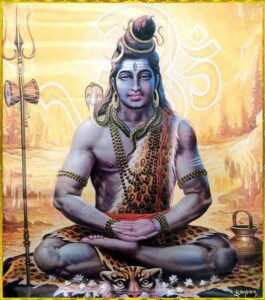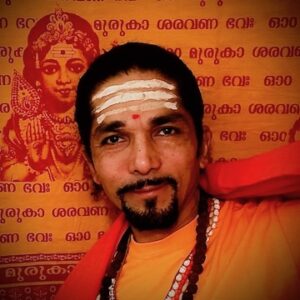by Baba Ghanshyam Puri
The first time I heard of Maha Shivaratri was in Kathmandu, Nepal. Maha Shivaratri is the night of Shiva. During this night, devotees remain awake in contemplation and chant mantrams for the deity known as Shiva in order to receive his auspiciousness. I had the opportunity to experience Maha Shivaratri in Nepal and India on repeated occasions and got involved with it for the first time during my travels in Nepal with Swami Chidananda of the New York IYI as my Guruji and guide.
Swamiji informed me that Shivaratri would take place a few days after the end of my stay in Kathmandu, so I decided to change the departure ticket in order to remain in Kathmandu for the celebration of Maha Shivaratri. Unfortunately, Swamiji did not stay with me as he continued his pilgrimage towards India. I remained by myself in Kathmandu. On the night of Shiva I attended the temple Pashupatinath dedicated to Shiva as his aspect of the Lord of the Animals. It was crowded with thousands of people inside and outside.
There was a mysterious power, an invisible energy present everywhere, which would be felt more intensely when I was chanting with the Sadhus. Pashupatinath is the most important Shiva temple in Nepal. Subsequent occasions of the celebration of Shivaratri took took place in India following this first experience, particularly in Aluva and Keezathingal, Kerala during two different years.
Before the pandemic began, I participated in Maha Shivaratri at the Shiva Murugha Temple of Concord, California, located about an hour north of San Francisco. We chanted Mantras all night including Rudram Chamakam of the Vedas. Yogis who want to achieve immortality perform rituals with water from Holy Rivers. Therefore, on my return from India I brought water from the Holy Rivers Ganges and Yamuna and the pandit or priest used this holy water to perform abhishekam (bath) of the Shiva Lingam at the Temple in Concord. I was quite happy to bring the holy water all the way from India to the U.S. for its use during Maha Shivaratri.
I. INTRODUCTION TO SHIVA AS THE OMNISCIENT YOGI
MEANING OF SHIVA: Shiva literally means the auspicious one. He is also known as Mahadeva, meaning the Great God. Shiva is one of the main deities of Hinduism and the supreme Being in Shaivism, one of the major traditions within Hinduism. Shiva has pre-vedic tribal roots. The figure we know today is an amalgamation of various older vedic and non-vedic deities, including Rudra of the Rig Veda, the Storm God. Shiva is the deity most commonly called Ishwara or the Lord in yogic thought, and is also referred to as Parameshwara or Supreme Lord.
Shiva is the primal Atman, Soul or Self of the Universe. He has both benevolent and fearsome depictions. As an omniscient yogi he lives an ascetic life on Mount Kailash, and also as a householder with his wife Parvati and his two children, Ganesha and Kartikeya. Shiva is also depicted as a destroyer, in which he appears slaying demons; hence, Shiva is known as the destroyer within the trimurti, the Hindu trinity that includes Brahma and Vishnu.
II.DIFFERENT TRADITIONS
SHAIVITE – Shiva is the supreme Lord who creates, protects and transforms the universe.
SHAKTA – In this tradition, the Goddess, or Devi, is described as one of the supreme deities and Shiva is revered along with Vishnu and Brahma. A Goddess is considered the energy and creative power (Shakti) of each, with Paravati (Sati) the equal complementary partner of Shiva.
SHIVA AS YOGI — Shiva is known as Adiyogi Shiva, regarded as the patron god of yoga, meditation, and arts.
ICONOGRAPHY AND SHIVALINGAM – the symbolic attributes of Shiva are many. Shiva is worshipped in the aniconic form of Lingam with the absence of material representations of natural and supernatural worlds.
III. SHIVA:THE OMNISCIENT YOGI
There is a strong connection of yoga and the symbolism of Shiva. Once I realized the many different aspects and symbols of Shiva related to yoga, I decided to embrace those attributes as part of my own yoga sadhana. As I began to understand more about Shiva and the calm he represents, I embraced prathyahara and dharana and began to experience dhyana. As a result, the path to Samadhi became more clearly pointed out as well.
Shiva represents a panoply of the important essential yogic factors like calm, balance, and dissolution of attachments. Below is a short description of some of them:
NIRODAHA: CALMING MENTAL DISTURBANCES THROUGH THE POWER OF STILLNESS
Shiva is the prime deity governing stillness and silence that is the state of Nirodha or Nirvana, in which the disturbances of the mind and heart are dissolved. “Chitta Vritti Nirodha” or calming the disturbances of the mind. Nirodha is the Shiva Principle of peace and stillness in Yoga.
BALANCE, AWARENESS, CALM, PRESENCE
In meditation we realize Shiva represents the original essence and power of yoga. All forms of yoga involve emulating certain qualities associated with Shiva and his energies of stillness and transformation. We can say that the “State of yoga” is the “State of Shiva”, where Shiva symbolizes balance, silence, steadiness, awareness, calm, and presence; these are the factors that constitute the essence of all Yoga practices. Other aspects of Shiva relate to his power of stillness to release attachments and karmic compulsions based on prior impressions or vasanas.
SHIVA IS THE REALIZATION OF THE COSMIC PERSON PRUSHA, who is the witness beyond all the fluctuations of body and mind, and disturbances of the gunas or external qualities of nature. Swami Satchidananda in his commentary mentions that: “You are the Seer who wants to see itself… …the Seer, or true you, reflects in the mind which is your mirror.” YS 1.3; pp 6, 7. The state of Being Shiva can be defined as the supreme state of detachment and observation.
The last part I want to mention relates to the yoga sutras of Patanjali which mention how to develop the faculty of witnessing and samadhi. Patanjali’s Yoga Sutras describe Shiva as the Seer, the witness of all, beyond birth and death. Yoga works through developing this “seer-power” in the seat of meditation. The steps to achieve this skill involve calming the mind and developing a state of intense concentration called Samadhi or absorption. This is the main means of any Yoga practice.
I.23 Isvarapranidhanad va: surrendering to ishvara as means to samadhi “…or by devotion with total dedication to God – Ishvara, as a means to reach Samadhi.”
I.27 Tasya vacakah pranava: OM as means to contact Ishvara: The main means of contacting Ishvar is through Pranava or primordial sound vibration, the seed mantra OM.
In our yoga we discover Shiva’s power of perfect peace within ourselves. Maha Shivaratri is an occasion for all yogis and devotees to reflect on how to connect more deeply to the essence of their practice at every level, especially towards the development of the sadhana’s subtle aspects conducive to reaching Samadhi.
Please join me and Swami Ramananda for a celebration of Mahashivaratri. We will contemplate the attributes and forms of Shiva and lead a puja, followed by chanting. Details for this online event can be found at this LINK.
OM NAMAH SHIVAYA
Baba Ghanshyam Puri is a Bhakta who has practiced yoga for over twenty five years and is certified to teach all levels of Hatha Yoga and Stress Management. He is a former attorney who became an Integral Yoga Teacher in 2010. He has taught in the United States, Mexico, Spain, and India. “Yoga can point the path to the Divine”, he sustains.
His devotion to the Guru, Swami Satchidananda, led him to India to experience the teachings of Gurudev directly. Puri resided temporarily at the Divine Life Society in Rishikesh, India, where he studied at the Yoga Vedanta Forest Academy. The following years, Babaji went on extensive pilgrimages throughout all India, Nepal, and other countries. In 2017 he completed the Maha Yatra or great trip to the Twelve Temples of Lord Shiva known as Jyotirlingas. Subsequently, he took Vel Kavadi for purification purposes in 2018. The following year he attended Maha Kumbh Mela in Prayagraj and took Shahi Snan (holy bath for purification) with the order of Naga Babas of Juna Akhara. Puri took Diksha or initiation and became a member of Juna Akhara in February 2019 at Kumbh Mela. Babaji is an Ayurvedic Life-Style Consultant, leads yoga retreats in Mexico, teaches classes online, and since 2011 has been leading community classes in San Francisco.


